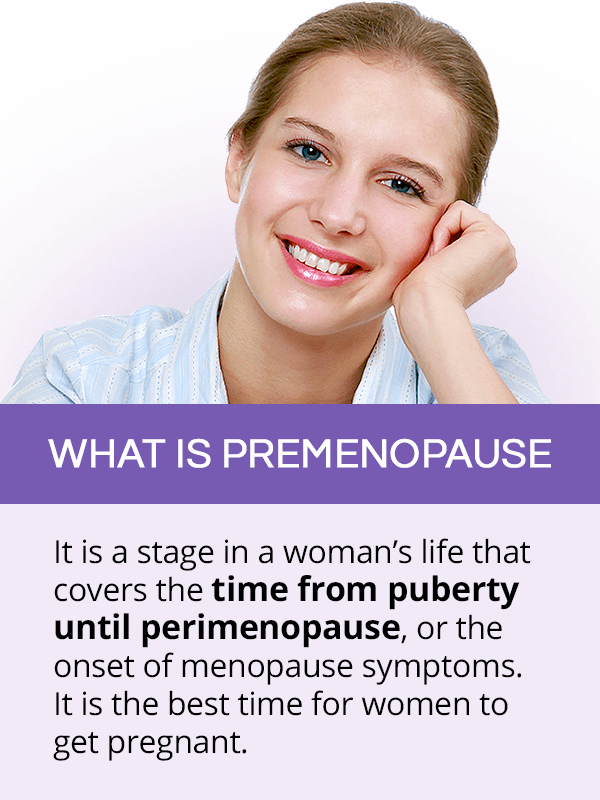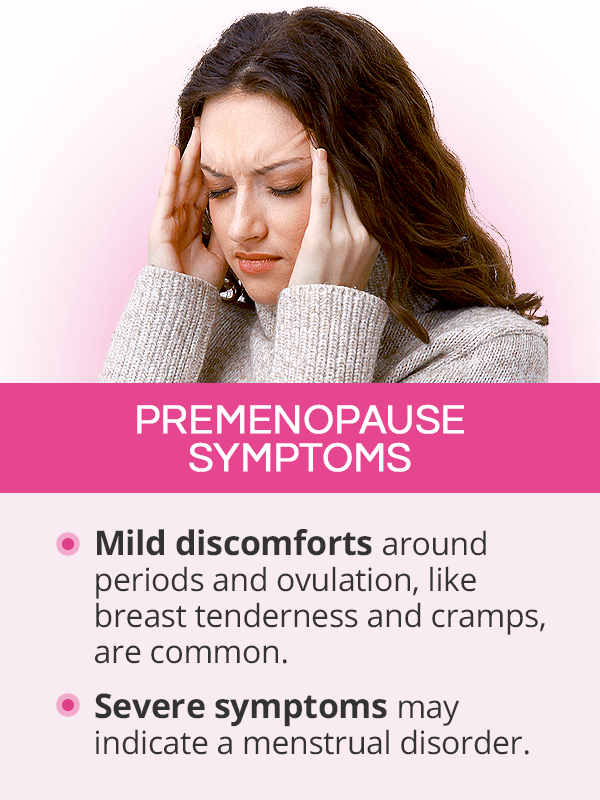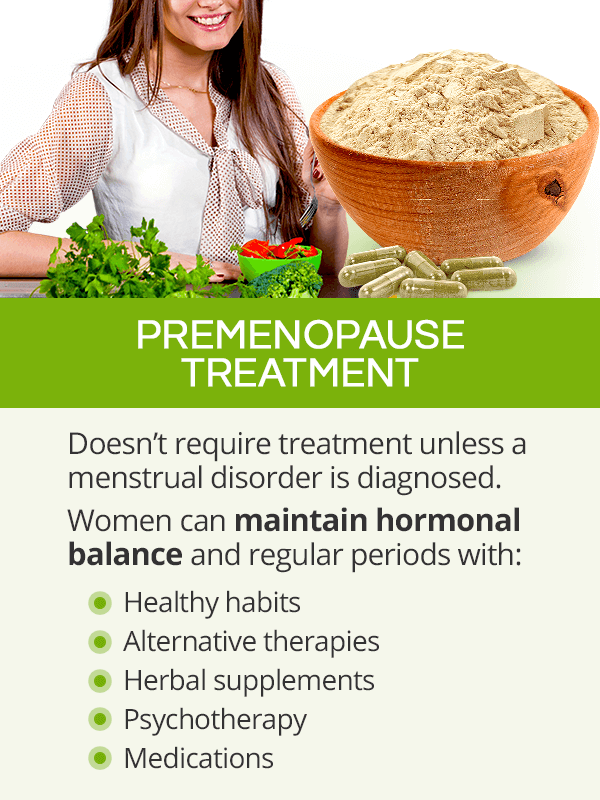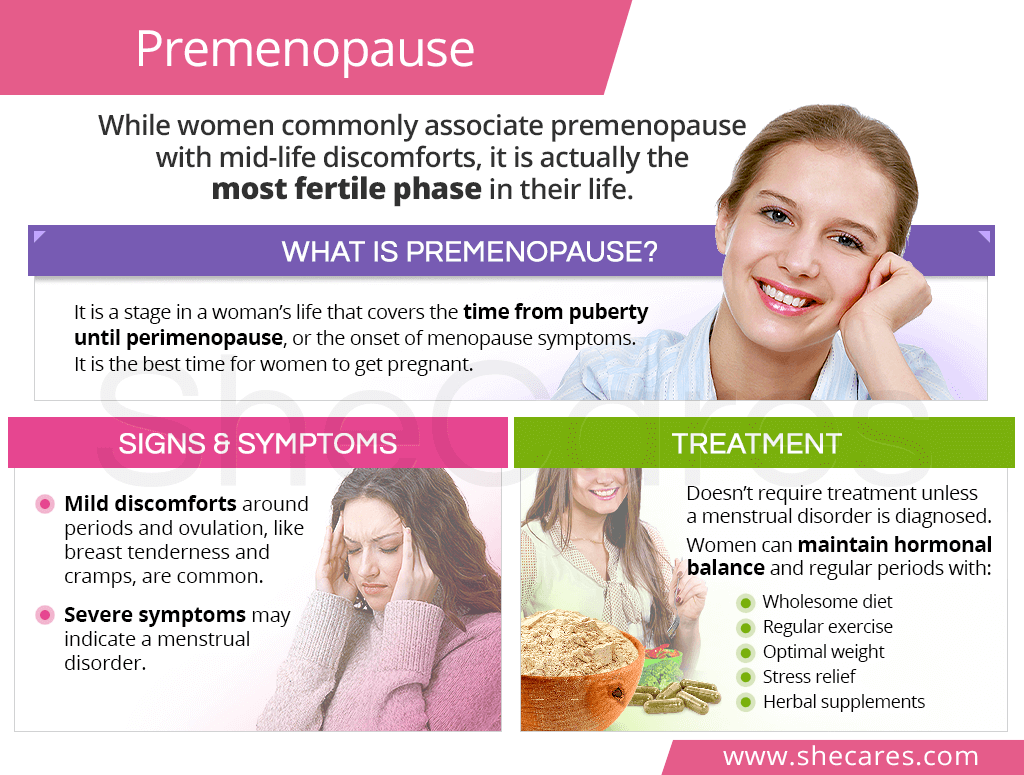What is Premenopause?

Premenopause is a stage in a woman's life that covers the time between puberty and perimenopause, about 30 years. Throughout that stage, a woman is considered to be in her prime reproductive years.
It is worth noting that terms “perimenopause” and “premenopause” are often used interchangeably. However, they signify two different life phases.
For reference, perimenopause is the stage immediately preceding menopause, which marks the end of her reproductive years. This is when she will begin experiencing a range of menopause symptoms, such as hot flashes and vaginal dryness. It usually starts in the mid 40s and can last from a few months to over 10 years.1
Premenopause Symptoms

There are no specific symptoms of premenopause per se. During each month, there are two instances when women may experience certain discomforts, around the times of their periods and ovulation:
Most healthy premenopausal women will enjoy regular menses with very mild or no discomforts. These so-called normal period symptoms - such as cramps, bloating, and breast tenderness - start a day or two before a period and last for a day or two into a period, without interfering with women's daily functioning.
It is also normal for women to experience mild ovulation symptoms roughly in the middle of the cycle, including slight pelvic or abdominal pain, breast tenderness, increased libido, and moodiness.
More severe discomforts around a menses that go beyond what is considered healthy may indicate a menstrual disorder. They are discussed in the section below.
Premenopause and Menstrual Disorders
It is not uncommon for women to accept various, oftentimes debilitating, symptoms as a normal part of menstruation. While occasional irregularities are common, consistently severe discomforts are not normal and need to be evaluated.
There are three types of menstrual disorders that may happen during premenopause:
Irregular Periods
Throughout premenopause, women may experience occasional irregular periods that do not need treatment. It is because periods are driven by hormones, whose levels can be influenced by a variety of factors, including unhealthy lifestyle habits.
However, if they persist for longer than three months, they may be triggered by an underlying hormonal imbalance or other causes that will require prompt intervention. They include absent periods, light menses, irregular ovulation, and others.
Premenstrual Syndrome
Premenstrual syndrome (PMS) is another menstrual disorder that is common during premenopause. It is said to affect about 75% of women of reproductive age.2
It causes a range of mild to moderate physical and emotional symptoms that can start one or two weeks before a woman's period. They can include mood swings, acne, fatigue, headaches, and sleep problems.
Premenstrual Dysphoric Disorder
Between 3 to 8% of premenopausal women experience premenstrual dysphoric disorder, or PMDD.3 This more severe version of PMS is classified as a mental health disorder and is known to significantly disrupt women's lives.
PMDD causes extreme psychological symptoms, including anger, irritability, depression, and apathy, that appear about a week before a period and last for a few days after it starts.
Premenopause Treatment

Most women do not need any premenopause treatment unless they have a diagnosed menstrual disorder or another condition that may affect their periods, fertility, and well-being.
Options for Premenopausal Women with Regular Periods
For women with regular menses, efforts can be put on maintaining hormonal balance to prevent potential irregularities. This can be done through a balanced diet with phytoestrogenic foods, regular exercise, and stress-relief techniques.
In addition, women are encouraged to track their periods to stay on top of their monthly patterns, especially if they are planning to get pregnant in the nearby future.
Options for Premenopausal Women with Menstrual Disorders
For women with menstrual disorders in premenopause, treatment will depend on their type and specific cause. Those due to hormonal imbalances can be tackled with healthy lifestyle habits as well as alternative and conventional medicine approaches.
Alternative options include supplements aimed at resolving nutritional deficiencies or balancing hormones. The latter come in two types: short-term, phytoestrogenic supplements, like chasteberry, or long-term, hormone-regulating supplements, like Macafem.
- Conventional options, on the other hand, may include a variety of medications as well as surgical interventions.
Key Takeaways
Premenopause extends from a woman's very first period to when she begins experiencing symptoms of the subsequent stage, called perimenopause. Those 30+ years are the best time to get pregnant, if a woman chooses to do so. While premenopause does not come with specific symptoms on its own, it is common for women to experience a range of mild symptoms around their periods and ovulation. If they are severe and affect their daily functioning, they may signal an underlying menstrual disorder. In such cases, premenopausal women can choose from a variety of natural, alternative, and conventional treatments. Those with regular periods and fertility can easily maintain hormonal balance and menstrual patterns with wholesome lifestyle changes.
Sources
- American College of Obstetricians and Gynecologists. (2020). The Menopause Years. Retrieved February 15, 2021 from https://www.acog.org/womens-health/faqs/the-menopause-years
- Baylor College of Medicine. (n.d.). Menstrual Disorders. Retrieved February 15, 2021 from https://www.bcm.edu/healthcare/care-centers/obstetrics-gynecology/conditions/menstrual-disorders
- Cleveland Clinic. (n.d.). Menopause, Perimenopause and Postmenopause. Retrieved February 15, 2021 from https://my.clevelandclinic.org/health/diseases/15224-menopause-perimenopause-and-postmenopause
- Harvard Health Publishing. (2019). Menopause and Perimenopause. Retrieved February 15, 2021 from https://www.health.harvard.edu/a_to_z/menopause-and-perimenopause-a-to-z
- Mayo Clinic. (2019). Menstrual cycle: What's normal, what's not. Retrieved February 15, 2021 from https://www.mayoclinic.org/healthy-lifestyle/womens-health/in-depth/menstrual-cycle/art-20047186
- Office on Women's Health. (2018). Your menstrual cycle and your health. Retrieved February 15, 2021 from https://www.womenshealth.gov/menstrual-cycle/your-menstrual-cycle-and-your-health
- The North American Menopause Society. (n.d.). Are We There Yet? Navigate Now with Our Guided Menopause Tour. Retrieved February 15, 2021 from https://www.menopause.org/for-women/menopauseflashes/menopause-symptoms-and-treatments/are-we-there-yet-navigate-now-with-our-guided-menopause-tour
Footnotes:
- Cleveland Clinic. (2019). Menopause, Perimenopause, and Postmenopause. Retrieved February 15, 2021 from https://my.clevelandclinic.org/health/diseases/15224-menopause-perimenopause-and-postmenopause
- Journal of Psychiatry & Neuroscience. (2000). Premenstrual syndrome and premenstrual dysphoric disorder: guidelines for management. Retrieved February 15, 2021 from https://www.ncbi.nlm.nih.gov/pmc/articles/PMC1408015/
- Casper. R. (2019). Patient education: Premenstrual syndrome (PMS) and premenstrual dysphoric disorder (PMDD). Retrieved February 15, 2021 from https://www.uptodate.com/contents/premenstrual-syndrome-pms-and-premenstrual-dysphoric-disorder-pmdd-beyond-the-basics
